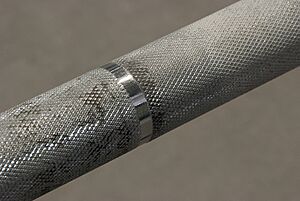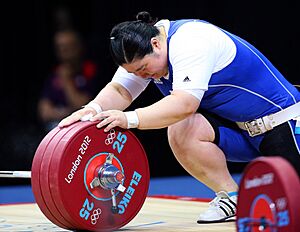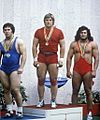Olympic weightlifting facts for kids
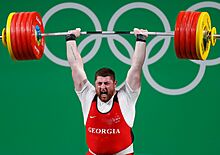
Olympic weightlifter Lasha Talakhadze lifting 258 kg at the 2016 Olympic Games in Rio, Brazil
|
|
| Highest governing body | International Weightlifting Federation |
|---|---|
| First developed | Ancient Greece |
| Characteristics | |
| Contact | No |
| Mixed-sex | No |
| Type | Power sport |
| Equipment | Barbells, weight plates, collars, chalk, tape, heel-elevated shoes, belt, knee sleeves, wrist wraps |
| Presence | |
| Country or region | Worldwide |
| Olympic | Men: 1896, 1904, 1920–present; Women: 2000–present |
| World Games | Women: 1997 |
Weightlifting (often known as Olympic weightlifting) is a sport in which athletes compete in lifting a barbell loaded with weight plates from the ground to overhead, with the aim of successfully lifting the heaviest weights. Athletes compete in two specific ways of lifting the barbell overhead. The snatch is a wide-grip lift, in which the weighted barbell is lifted overhead in one motion. The clean and jerk is a combination lift, in which the weight is first taken from the ground to the front of the shoulders (the clean), and then from the shoulders to over the head (the jerk). The sport formerly included a third lift/event known as clean and press.
Each weightlifter gets three attempts at both the snatch and the clean and jerk, with the snatch attempted first. An athlete's score is the combined total of the highest successfully-lifted weight in kilograms for each lift. Athletes compete in various weight classes, which are different for each sex and have changed over time.
Weightlifting is an Olympic sport, and has been contested in every Summer Olympic Games since 1920. While the sport is officially named "weightlifting", the terms "Olympic weightlifting" and "Olympic-style weightlifting" are often used to distinguish it from the other sports and events that involve the lifting of weights, such as powerlifting, weight training, and strongman events. Similarly, the snatch and the clean and jerk are known as the "Olympic lifts".
While other strength sports test limit strength, Olympic-style weightlifting also tests limits of human power (explosive strength): the olympic lifts are executed faster, and require more mobility and a greater range of motion during their execution, than other barbell lifts. The Olympic lifts, and their variations (e.g., power snatch, power clean)as well as components of the Olympic lifts (e.g., cleans, squats) are used by elite athletes in other sports to train for both explosive strength (power) and functional strength.
Contents
Competition
The sport is competed at local, national, and international levels. The sport is governed internationally by the International Weightlifting Federation (IWF), which runs the World Weightlifting Championships each year.
Component lifts
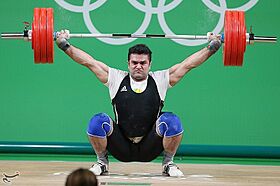
The snatch is a lift wherein an athlete sweeps the barbell up and overhead in one fluid action: the lifter takes a wide-grip on the bar and pulls the barbell off the floor before rapidly re-bending their knees to get themself under the barbell (usually bringing themself into a deep overhead squat position), so that the barbell is supported over their head with arms outstretched. The snatch is then completed by the lifter rising to a standing position while holding the barbell overhead. The snatch demands precise balance.
The clean and jerk is a combination lift, in which the athlete gets the barbell overhead in two stages: first by lifting the barbell into support on the front of the shoulders, a position known as the front rack (the clean), and then lifting it from shoulders to overhead (the jerk). To perform the clean, the lifter takes a shoulder-width grip on the bar and pulls it off the floor, and then rapidly re-bends their knees (and bends their arms) to get their body under the barbell and "catch" the bar on the front of the shoulders (usually in a deep front squat position). The lifter finishes the clean by rising to a standing position while holding the barbell on the front of their shoulders. The lifter then uses the jerk to jump into a bent knees position (most commonly with one foot forward and the other back, a technique known as the split jerk) while pumping the barbell overhead. The jerk is completed when the lifter re-straightens the legs (bringing them together after a split jerk) so they come to a straight standing position with the barbell held overhead.
A third lift, the clean and press, was also a competition lift from 1924 through 1972. It entails a clean followed by an overhead press. The overhead press is distinguished from the jerk, in that jerking movements, bending of the legs, and displacement of the feet are prohibited. It was discontinued after 1972 due to difficulties in judging proper form.
Weight classes
Athletes compete in a division determined by their body mass. In summer 2018, the IWF approved the current weight categories, specifying which 7 of the 10 total would be contested at the 2020 Summer Olympics.
IWF Men's weight classes:
Categories
- 55 kg (121 lb)
- 61 kg (134 lb)
- 67 kg (148 lb)
- 73 kg (161 lb)
- 81 kg (179 lb)
- 89 kg (196 lb)
- 96 kg (212 lb)
- 102 kg (225 lb)
- 109 kg (240 lb)
- 109 kg and over (240 lb+)
Only five weight classes were chosen for Paris 2024:
- 61 kg, 73 kg, 89 kg, 102 kg and over 102 kg.
IWF Women's weight classes:
Categories
- 45 kg (99 lb)
- 49 kg (108 lb)
- 55 kg (121 lb)
- 59 kg (130 lb)
- 64 kg (141 lb)
- 71 kg (157 lb)
- 76 kg (168 lb)
- 81 kg (179 lb)
- 87 kg (192 lb)
- 87 kg and over (192 lb+)
Weight classes chosen for Paris 2024:
- 49 kg, 59 kg, 71 kg, 81 kg and over 81 kg.
Official procedure
In each weight division, lifters compete in both the snatch and the clean and jerk. Prizes are usually given for the heaviest weights lifted in each and in the overall—the maximum lifts of both added. The order of the competition is up to the lifters—the competitor who chooses to attempt the lowest weight goes first. If they are unsuccessful at that weight, they have the option of reattempting at that weight or trying a heavier weight after any other competitors have made attempts at the previous weight or any other intermediate weights. The barbell is loaded incrementally and progresses to a heavier weight throughout the course of competition. Weights are set in 1-kilogram increments. If two athletes lift the same weight, they are both credited with it but in terms of placing the one who lifted the weight first gets the highest placing.
During competition, the snatch event takes place first, followed by a short intermission, and then the clean and jerk event. There are two side judges and one head referee who together provide a "successful" or "failed" result for each attempt based on their observation of the lift within the governing body's rules and regulations. Two successes are required for any attempt to pass. Usually, the judges' and referee's results are registered via a lighting system with a white light indicating a "successful" lift and a red light indicating a "failed" lift. This is done for the benefit of all in attendance be they athlete, coach, administrator or audience. In addition, one or two technical officials may be present to advise during a ruling.
Lifters who fail to successfully complete at least one snatch and at least one clean and jerk fail to total, and receive an "incomplete" entry for the competition.
Local competition rules
At local competitions, a "Best Lifter" title is commonly awarded. It is awarded to both the best men's and women's lifters. The award is based on a formula which employs the "Sinclair coefficient", a coefficient derived and approved by the sport's world governing body, which allows for differences in both gender and bodyweight. When the formula is applied to each lifter's overall total and then grouped along with the other competitors' and evaluated, it provides a numeric result which determines the competition's best overall men's and women's lifters. And while, usually, the winner of the heaviest weight class will have lifted the most overall weight during the course of a competition, a lifter in a lighter weight class may still have lifted more weight both relative to their own bodyweight, and to the Sinclair coefficient formula, thereby garnering the "Best Lifter" award.
Equipment
Barbell
Olympic weightlifting uses a steel bar (also known as a barbell) with larger-diameter rotating sleeves on either end, holding rubber-coated weight plates of different weights. This sleeve rotation is important for the Olympic lifts, particularly the snatch and clean movements, because it drastically reduces the rotational inertia of the bar. Without sleeve rotation, the Olympic lifter faces more challenging lifts and a greater risk of injury.
A men's Olympic barbell weighs 20 kg (44 lbs) with a shaft diameter of 28 mm and a length of 2200 mm, whereas a women's Olympic barbell weighs 15 kg (33 lbs) and has a shaft diameter of 25 mm with a length of 2010 mm. The distance between the sleeves, however, is the same for the men's and the women's bars at 1310 mm. The grip texture of the bar is called the knurling, and is distributed differently between the men's and women's bars: the men's has knurling in the center but the women's does not. The Olympic barbells used in competition are certified by the IWF.
Bumper plates
The weight plates, typically referred to as "bumper plates" because of their rubber coated design, weigh between 10 kg and 25 kg in 5 kg increments. The bumper plates are coated with rubber to allow the weights to be dropped from various heights—either after a successful lift or during an unsuccessful one. Olympic bumper plates conform to international standards for coloring. That is, 10 kg is green, 15 kg is yellow, 20 kg is blue, and 25 kg is red.
Competition iron plates
In addition to the rubber bumpers, smaller competition iron plates can be used to add weight in small increments to the bar. The color designations for these iron plates are as follows: 1 kg is green, 1.5 kg is yellow, 2 kg is blue, 2.5 kg is red, 5 kg and 0.5 kg are white. It is useful to note the color assignment of these iron plates is consistent with the heavier bumper plates (i.e. 1 kg and 10 kg are green, 1.5 kg and 15 kg are yellow, etc.).
Collars
Weight plates are secured to the bar using collars on each sleeve that weigh exactly 2.5 kg each.
Singlet
Lifters typically wear a one-piece close-fitting leotard often called a singlet. The wearing of a T-shirt underneath the singlet is optional.
Belt
A weightlifting belt of 120 mm maximum width may also be worn to increase intra-abdominal pressure.
Chalk
Chalk is regularly used by Olympic lifters, generally prior to each attempt at a lift. Lifters rub their hands with the chalk to promote dryness and prevent the bar moving in their hands.
Tape
Olympic lifters frequently use tape to cover the areas of their bodies exposed to friction while completing Olympic lifts. Tape is most commonly found on the Olympic lifter's thumb. A taped thumb not only lessens the risk of calluses, but it also reduces the pain associated with the hook grip.
Olympic lifters also tape their wrists, preventing exaggerated and uncomfortable joint movement during lifts. For particularly heavy overhead lifts, a taped wrist enables the lifter to regulate wrist extension and delimit the translation of the radius and ulna distal heads. However, while taped wrists can prevent wrist and forearm injuries in the short-term, excessive use can lead to weakened connective tissue in the area, increasing the risk of pain and injury.
Shoes
The type of shoes worn by Olympic weightlifters is perhaps their most distinctive piece of equipment. Weightlifting shoes are typically designed with a raised heel of 0.5" to 1.5" and one or two metatarsal straps that tighten across the instep of the shoe. The raised heel helps the lifter maintain an upright torso while catching the bar and also allows for a deeper squat under the bar. The soles of the shoes are also quite rigid, helping to resist compression while under heavy loads. The shoes are designed for maximum stability while remaining flexible in the toe box. This allows the lifter to come up on the toes and to catch the weight on the ball of the back foot during the "jerk" movement of the lift.
There are also different heel constructions. Most modern Weightlifting shoes use a hard TPU plastic heel that does not deform and is more durable than other materials. However, there has been a resurgence in premium shoes using retro wood heels which are hard but do not last as long.
Knee sleeves
Some weightlifters may use knee sleeves to provide joint support and assist in standing from the deep squatting position.
Wrist wraps
Wrist wraps are commonly used to provide support to the joint.
Related pages
Images for kids
-
The 110 kg division weightlifting winners at the 1980 Summer Olympics, held in Moscow
See also
 In Spanish: Halterofilia para niños
In Spanish: Halterofilia para niños
- Weightlifting at the Summer Olympics
- List of world records in Olympic weightlifting
- List of Olympic records in weightlifting
- List of Olympic medalists in weightlifting
- Powerlifting
- Power training
- Paralympic powerlifting



